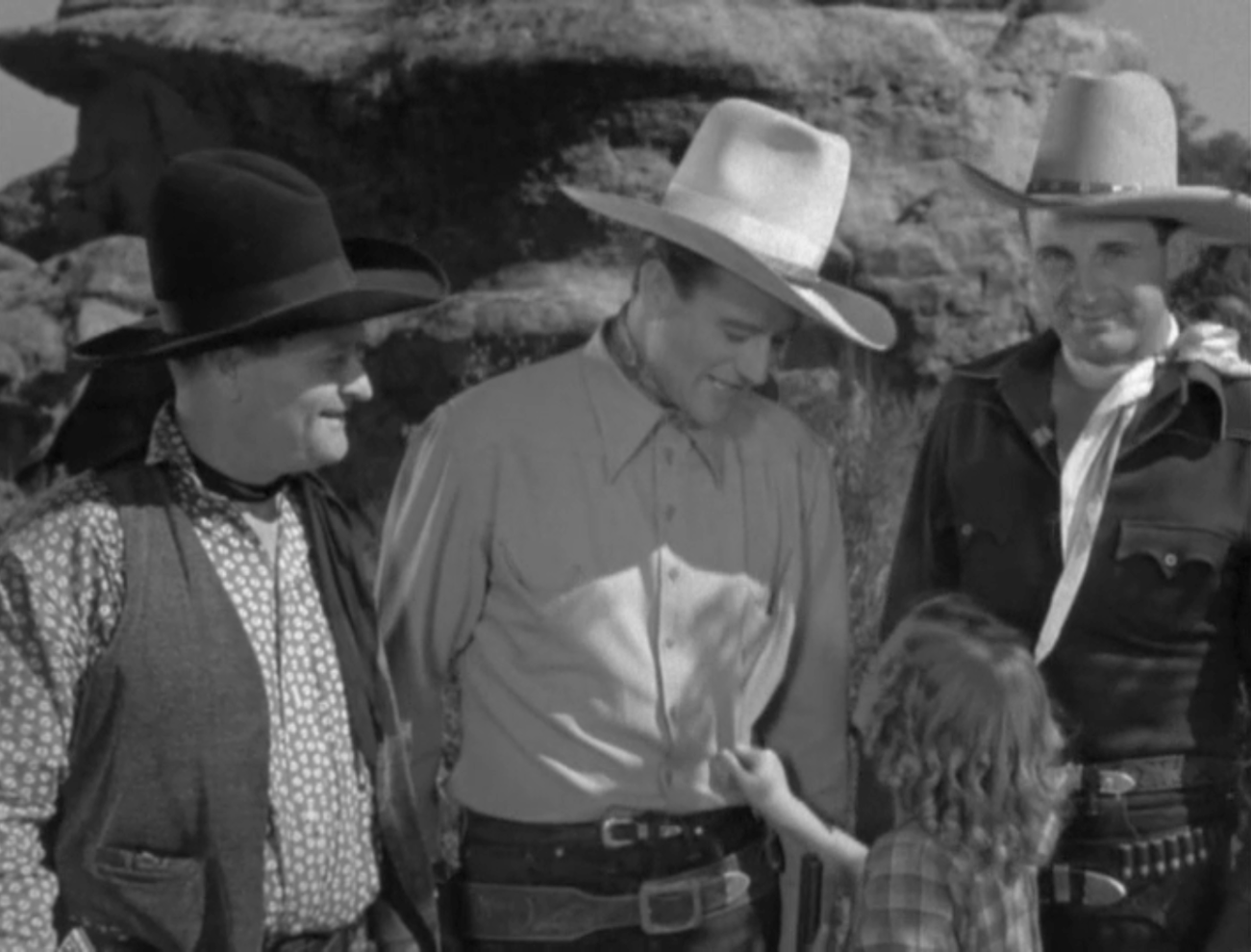It's a little surprising that John Wayne, probably the biggest Western movie star of them all, only rarely worked on the Iverson Movie Ranch, the most heavily filmed Western movie shooting location by a long stretch. I know of only two Westerns in which the Duke put in time at Iverson: his breakthrough role in John Ford's 1939 masterpiece "Stagecoach," and a much lower-profile appearance the previous year in "Overland Stage Raiders." He also made a high-profile war movie, "The Fighting Seabees," at Iverson in 1944.
"Overland Stage Raiders" was made before Wayne became a big star, when he was still paying his dues playing Stony Brooke in Republic's low-budget Three Mesquiteers series. Wayne did get top billing over fellow Mesquiteers Ray "Crash" Corrigan and Max "Alibi" Terhune, but not by much.
Four of the key players in "Overland Stage Raiders" appear in a publicity shot for the movie. In the back row, from left, are John Wayne, Louise Brooks and Ray Corrigan, with Max Terhune in front. Wayne appeared in a total of eight of Republic's Three Mesquiteers features in the span of a little more than a year, from 1938-1939.
John Wayne leads the charge across the Upper Iverson in a blurry screen shot from "Overland Stage Raiders."
Here Wayne and his fellow Mesquiteers work the Gorge on the Lower Iverson.
A still shot offers a better look at Ray Corrigan, left, and John Wayne at work on the Lower Iverson in "Overland Stage Raiders" in 1938. Corrigan was already setting up his own movie location ranch at the time, having bought property in Simi Valley in 1937 and beginning construction on what would become Corriganville — one of the few location ranches to rival the success of Iverson during the heyday of the B-Western.
Wayne and Brooks continued to connect at the wrap party for "Overland Stage Raiders."
A later poster for the movie gives greater heft to its star, John Wayne, after his career began to take off.
"Santa Fe Stampede" (1938) — Upper Iverson in the background, via rear projection
John Wayne does appear in a couple of other Three Mesquiteers movies that contain some Iverson footage, but as far as I can tell neither of these would have required the Duke to show up at Iverson. The "Santa Fe Stampede" shot above features the Upper Iverson in the background, but the lighting makes it pretty obvious the shot is done in the studio using rear projection. That's silent movie great William Farnum on the left, in one of his later roles, with child actress Genee Hall at center, jammed between the once and future legends.
"Santa Fe Stampede" — The Duke, center, on Brandeis Ranch in Chatsworth, Calif., interacting with young Genee Hall. The other Mesquiteers are again Max Terhune, left, and Ray "Crash" Corrigan.
The Duke did make his way to Chatsworth during filming for "Santa Fe Stampede" — and in fact, probably had to drive across the Iverson Ranch to get to work. That's because some of the location filming on the movie was done at Brandeis Ranch, Iverson's immediate neighbor to the west — and the entrance road to Brandeis ran through Iverson.
"Santa Fe Stampede": Brandeis Movie Ranch, with portions of the Upper Iverson in the background
With Brandeis and Iverson adjacent to each other, the two filming locations frequently appeared in the backgrounds of each other's movies, as in the example above. This scene prominently features a rock I call the Brandeis Toad, nearest the center of the frame. A little bit of the Upper Iverson is visible in the background, along with some familiar features to the east of Iverson.
Here's the same shot with some key features spotlighted. Cactus Hill and the rocks just below it are on Iverson property, while Two-Humper and Notch Hill are located east of Iverson and show up regularly in the backgrounds of productions filmed on the ranch. Brandeis, which was also known during the late 1930s as the Lazy A Ranch, operated as a filming site for only a short time, with the bulk of the production taking place from 1935 to 1942.
Corriganville, in a scene from "Santa Fe Stampede"
Additional location work for "Santa Fe Stampede" took place a few miles to the west at Corriganville in Simi Valley, where Ray Corrigan's location ranch was now up and running. The large rock face in the background at right later became known as Fort Apache Rock, as it appeared regularly in scenes with Corriganville's widely used Fort Apache set.
Both Fort Apache Rock and the much smaller, but equally distinctive, beetle-shaped rock toward the left, which I've nicknamed "the Scarab," became familiar sights in the movies as Corriganville developed into a busy filming location during the 1940s and 1950s. The Scarab can still be found at the site, but Fort Apache Rock was partially destroyed in the 1960s to make way for the 118 Freeway — the same freeway that dealt a severe blow to filming at Iverson, several miles to the east.
The only other Western on my list of John Wayne's Iverson productions is another Three Mesquiteers feature from Republic, "Three Texas Steers," released in1939. The Iverson material in this one is minimal, consisting of barely visible archival footage, again inserted through rear projection. In all, Republic cranked out 51 installments of its Three Mesquiteers franchise, spanning 1936-1943, with John Wayne featured in eight of those efforts.

















No comments:
Post a Comment